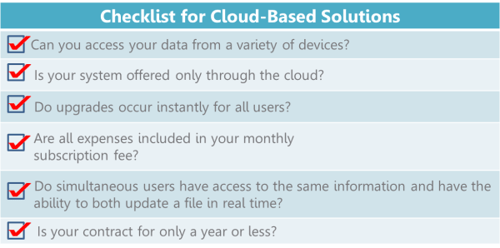How To Determine if a Practice Management System is Cloud-Based
There has been a lot of buzz surrounding cloud-based services in the optometry space, especially for practice management and EHR systems. But what exactly does it mean to be in the cloud? And to make things more complicated, there are many types of cloud models available. Without a lot of technical knowledge it can be hard to fully understand the differences between models. Even though many systems advertise themselves as cloud vendors, you should be aware of the differences between cloud-based and cloud-hosted models.
For a while, client-server practice management systems were the only option. Servers are hosted on-site at your practice and you are responsible for hardware installation, maintenance, security, and upgrades. But today, cloud systems outsource the hard work of dealing with hardware to the vendor. Within cloud systems, there are cloud-hosted solutions and cloud-based solutions. Heres the break-down:
- Cloud-Hosted Model: Mostly based on an application service provider (ASP), a cloud-hosted vendor provides a contractual service to host and manage your server remotely. Software must be downloaded or installed on the devices accessing the system.
- Cloud-Based Model: Also known as Software-as-a-Service (SaaS), a cloud-based system is made available to users, from any location via an Internet browser.
Are You Using a Cloud-Based Practice Management System?
1. Can You Access Your Data From a Variety of Devices?
Because all you need is an Internet connection and browser, it is easy to gain secure access to your data from a variety of devices using a cloud-based system. You have the ability to go room-to-room with a tablet in hand to deliver an efficient visit, or even take your work home if you need to.
Applications that are simply cloud-hosted can't be accessed through a URL, and require a specific hardware for the computer you plan to install the software on. This can create additional expenses. For example, if you want to access your system while out of the office you would have to purchase a VPN Client to reach your data from a remote location.
2. Is Your System Also Offered as an Installed Version?
SaaS models are built from the ground up, which means a system cannot simply move to a SaaS model. If your software has recently become available as a cloud solution with the option of an installed version, it is likely that it is an ASP, or cloud-hosted model. Installed versions should not be available from the start if your system is truly in the cloud.
3. What's the Upgrade Process Like?
Cloud-based systems are upgraded automatically so you can be sure that you are using the newest version every time you log in. Cloud-hosted systems are designed for individual providers, and upgrades have to be installed individually. Because it is time-consuming and costly, most ASP vendors combine many maintenance and upgrades at once, resulting in infrequent updates. Technology is ever-changing and the only way to keep up with the latest developments is to make sure you have the latest upgrades.
4. What Do All of Your Hidden Expenses Add Up To?
When considering the costs of cloud-based and cloud-hosted solutions, hidden fees typically set SaaS apart from. A true cloud-based solution often charges only a monthly subscription fee where maintenance fees are already included. You should pay attention to hidden costs outside the monthly subscription fee such as administration costs, upgrades, down payments, or maintenance fees. These are signs your system may not be truly cloud-based.
5. How Many Users Can Operate The System?
True cloud-based systems are designed so each customer can have a custom experience. This means you adopt the system as a whole practice, while giving each department the ability to customize the system to fit their specific needs, such as granting different permission levels. It's as simple as creating new log in accounts to give your employees access to the system from any device.
This unique feature is not possible with ASPs because they can only be configured by the provider. And the software must be installed on the computer of each user.
6. Do You Fully Understand Everything in Your Contract?
Contracts are a way for you to get a glimpse of the provider before you join. Some providers can tie you up in a contract for 5 years before you are able to switch to another system without penalties. When using a cloud-based solution, contracts can be as short as one month!
It's understandable why so many people get confused about cloud-based and cloud-hosted models. But the important differences between the two are that true cloud-based technology is more convenient, cost effective, and easier to use and maintain.
Still not sure if a practice management system is cloud-based? Go through the checklist and ask these questions. If you answer yes to all of them, your solution is most likely cloud-based!

Today more and more businesses are taking advantage of SaaS for their IT experience. Is your practice management system ready to take advantage of what cloud-based technology has to offer?
Get the modernized version of your hosted services and discover the benefits of the cloud!



